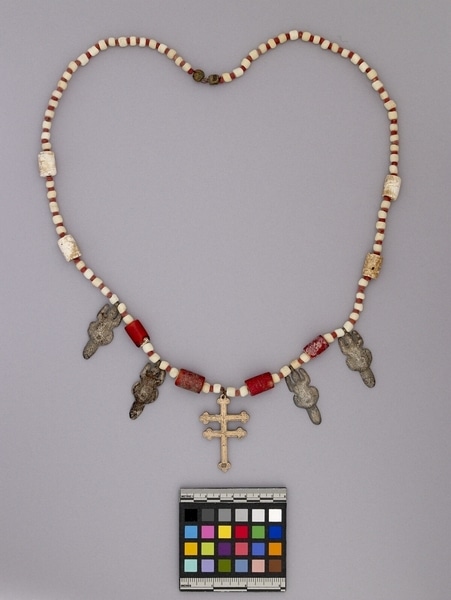Necklace Item Number: 1590/280 from the MOA: University of British Columbia

Description
Necklace consisting of small white and red glass beads, interspersed with 4 larger red-and-white beads and 4 larger white beads in different groupings, 2 small round brass beads side by side at the join, gold Lorraine cross with clover leaf terminals and zigzag border engraving, and 4 silver engraved beavers. Necklace strung on wire. Maker’s mark at bottom of the cross in a cartouche. Cartouches with no decipherable marks also on the backs of the beavers.
History Of Use
Animal imagery is a significant part of Woodland First Nations tradition, but no documented instance has been found of the use of animal effigies in trade. The place of effigies in Woodlands culture is not known.
Silver ornaments represent an important part of early exchange between Europeans, including fur traders, and First Nations peoples, especially in eastern and central Canada and the U.S.A. Initially, the main source of silver was British, French and Spanish coins. Most ornaments were produced by silversmiths of European origin in North America and Europe, and were actively traded only from 1760 to 1821. By the mid-18th century silver objects were produced in New England, Quebec and Montreal. Silver was used by First Nations peoples as a sign of rank. Silver ornaments in these styles continue to be produced by native silversmiths in central Canada and the U.S.A.
The cross was the oldest form of trade silver, introduced by French missionaries to North America for presentation to converts. Crosses were later used as trade silver with no religious connotations. They circulated well into the 19th century and were worn on the chest. The Lorraine cross has double bars.
Cultural Context
personal decoration; status
Specific Techniques
Rocker engraving is a freehand technique. Irregularity is characteristic.
Item History
- Made in Canada ? or USA ? between 1760 and 1821
- Owned by Kathleen E. Reif before September 9, 1993
- Received from Kathleen E. Reif (Donor) on September 9, 1993
What
Who
- Culture
- Eastern Woodlands
- Previous Owner
- Kathleen E. Reif
- Received from
- Kathleen E. Reif (Donor)
Where
- Holding Institution
- MOA: University of British Columbia
- Made in
- Canada ? or USA ?
When
- Creation Date
- between 1760 and 1821
- Ownership Date
- before September 9, 1993
- Acquisition Date
- on September 9, 1993
Other
- Item Classes
- metalwork
- Condition
- good
- Accession Number
- 1590/0280